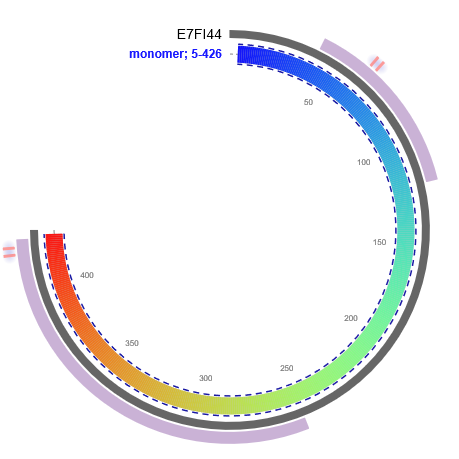ferredoxin hydrogenase activity ,hydrogen dehydrogenase activity.
MKNLYLPITIDHIARVEGKGGVEIIIGDDGVKEVKLNIIEGPRFFEAITIGKKLEEALAI
YPRICSFCSAAHKLTALEAAEKAVGFVPREEIQALREVLYIGDMIESHALHLYLLVLPDY
RGYSSPLKMVNEYKREIEIALKLKNLGTWMMDILGSRAIHQENAVLGGFGKLPEKSVLEK
MKAELREALPLAEYTFELFAKLEQYSEVEGPITHLAVKPRGDAYGIYGDYIKASDGEEFP
SEKYRDYIKEFVVEHSFAKHSHYKGRPFMVGAISRVINNADLLYGKAKELYEANKDLLKG
TNPFANNLAQALEIVYFIERAIDLLDEALAKWPIKPRDEVEIKDGFGVSTTEAPRGILVY
ALKVENGRVSYADIITPTAFNLAMMEEHVRMMAEKHYNDDPERLKILAEMVVRAYDPCIS
CSVHVVRL435

| PMID | Title & Author | Abstract | Year | |
| 0 | 2538471 | Characterization of hydrogenase from the hyperthermophilic archaebacterium, Pyrococcus furiosus. Bryant FO, Adams MW. | The archaebacterium, Pyrococcus furiosus, grows optimally at 100 degrees C by a fermentative type metabolism in which H2 and CO2 are the only detectable products. The organism also reduces elemental sulfur (S0) to H2S. Cells grown in the absence of S0 contain a single hydrogenase, located in the cytoplasm, which has been purified 350-fold to apparent homogeneity. The yield of H2 evolution activity from reduced methyl viologen at 80 degrees C was 40%. The hydrogenase has a Mr value of 185,000 +/- 15,000 and is composed of three subunits of Mr 46,000 (alpha), 27,000 (beta), and 24,000 (gamma). The enzyme contains 31 +/- 3 g atoms of iron, 24 +/- 4 g atoms of acid-labile sulfide, and 0.98 +/- 0.05 g atoms of nickel/185,000 g of protein. The H2-reduced hydrogenase exhibits an electron paramagnetic resonance (EPR) signal at 70 K typical of a single [2Fe-2S] cluster, while below 15 K, EPR absorption is observed from extremely fast relaxing iron-sulfur clusters. The oxidized enzyme is EPR silent. The hydrogenase is reversibly inhibited by O2 and is remarkably thermostable. Most of its H2 evolution activity is retained after a 1-h incubation at 100 degrees C. Reduced ferredoxin from P. furiosus also acts as an electron donor to the enzyme, and a 350-fold increase in the rate of H2 evolution is observed between 45 and 90 degrees C. The hydrogenase also catalyzes H2 oxidation with methyl viologen or methylene blue as the electron acceptor. The temperature optimum for both H2 oxidation and H2 evolution is greater than 95 degrees C. Arrhenius plots show two transition points at approximately 60 and approximately 80 degrees C independent of the mode of assay. That occurring at 80 degrees C is associated with a dramatic increase in H2 production activity. The enzyme preferentially catalyzes H2 production at all temperatures examined and appears to represent a new type of "evolution" hydrogenase. | 1989 |
| 1 | 18193215 | Relationship among growth parameters for Clostridium butyricum, hydA gene expression, and biohydrogen production in a sucrose-supplemented batch reactor. Wang MY, Olson BH, Chang JS. | This study was undertaken to identify the relationship between the performance of dark H2 fermentation and expression of the key functional gene (i.e., hydrogenase gene) involved in the bioH2 production process. Clostridium butyricum CGS5 isolated from anaerobic sewage sludge was used as the model strain for this study. Copy number of the hydrogenase gene (hydA) and mRNA transcripts (cDNA hydA) (after amplification) and the total DNA and RNA (before amplification) were measured over the course of the growth of strain CGS5. Cell concentration was also determined by optical density and converted to dry weight. After amplification, the hydA gene increased 1,500-fold during late exponential growth phase after normalization to the copy number at time 0, and cDNA from mRNA transcripts of hydA also increased 500-fold after normalization. mRNA transcripts of hydA lagged behind the increase of total DNA and RNA, and increases in hydA more closely mimicked those of total DNA. Increases in both of these parameters corresponded with hydrogen production. Transcripts of 16s ribosomal RNA reached a maximum value earlier (38 h) than did those of hydA (47 h). All molecular characteristics matched those for sucrose utilization, growth, and hydrogen production. These experiments indicated that transcription as measured by cDNA can be related to hydrogen production and possesses the potential to be used as tool for process control. | 2008 |
| 2 | 10585557 | The hydA gene encoding the H(2)-evolving hydrogenase of Clostridium perfringens: molecular characterization and expression of the gene. Kaji M, Taniguchi Y, Matsushita O, Katayama S, Miyata S, Morita S, Okabe A. | A putative hydrogenase (hydA) gene of Clostridium perfringens encodes a protein with strong identity to Clostridium pasteurianum hydrogenase I. Disruption of the hydA gene abolished H(2) productivity, confirming its function. A putative butyrate kinase gene (buk) is adjacent to the hydA gene. When cultures were grown in medium with glucose, 1.8-kb hydA and 2.1-kb buk transcripts and a 3. 9-kb transcript hybridized with both hydA and buk-probe were detectable in all the exponential growth phases. In medium without glucose, these transcripts were decreased rapidly after the mid-exponential phase. These results suggest that the transcription of these two genes is probably regulated by a similar mechanism in response to glucose availability. | 1999 |
Bryant F O , Adams M W W . Characterization of hydrogenase from the hyperthermophilic archaebacterium, Pyrococcus furiosus[J]. Journal of Biological Chemistry, 1989, 264(9):5070-5079.